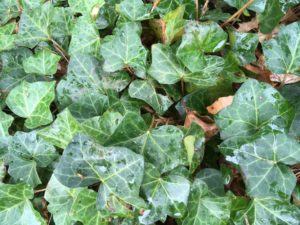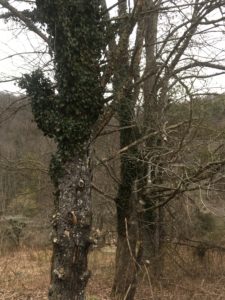English Ivy- Friend or Foe?
go.ncsu.edu/readext?595903
en Español / em Português
El inglés es el idioma de control de esta página. En la medida en que haya algún conflicto entre la traducción al inglés y la traducción, el inglés prevalece.
Al hacer clic en el enlace de traducción se activa un servicio de traducción gratuito para convertir la página al español. Al igual que con cualquier traducción por Internet, la conversión no es sensible al contexto y puede que no traduzca el texto en su significado original. NC State Extension no garantiza la exactitud del texto traducido. Por favor, tenga en cuenta que algunas aplicaciones y/o servicios pueden no funcionar como se espera cuando se traducen.
Português
Inglês é o idioma de controle desta página. Na medida que haja algum conflito entre o texto original em Inglês e a tradução, o Inglês prevalece.
Ao clicar no link de tradução, um serviço gratuito de tradução será ativado para converter a página para o Português. Como em qualquer tradução pela internet, a conversão não é sensivel ao contexto e pode não ocorrer a tradução para o significado orginal. O serviço de Extensão da Carolina do Norte (NC State Extension) não garante a exatidão do texto traduzido. Por favor, observe que algumas funções ou serviços podem não funcionar como esperado após a tradução.
English
English is the controlling language of this page. To the extent there is any conflict between the English text and the translation, English controls.
Clicking on the translation link activates a free translation service to convert the page to Spanish. As with any Internet translation, the conversion is not context-sensitive and may not translate the text to its original meaning. NC State Extension does not guarantee the accuracy of the translated text. Please note that some applications and/or services may not function as expected when translated.
Collapse ▲Groundcovers can serve an important purpose in the landscape. In shady sites where grasses do not grow well, shade-tolerant groundcovers protect the soil, reduce erosion, and provide green or other color in an area. Groundcovers may be grasses, broadleaf plants, and may have showy flowers to provide interest or color.

Known for it’s green glossy foliage, English ivy is a popular groundcover but it can become invasive in the landscape.
One of the most popular ground covers is English Ivy (Hedera helix). English Ivy is treasured for its glossy, deep green foliage, ability to tolerate poor soil conditions, grow rapidly, and adapt to a wide range of shaded to sunny sites. Once established, it requires little water or care to thrive. It is reknown for its ability to grow up and cover walls and trees, drape itself over walkways and dangle its vines, and add an earthy touch to brick buildings.
But like many plants that people cultivate for their ability to establish rapidly and tolerate poor conditions, English ivy is not a native plant, and it can be invasive. It will outcompete many slower growing species, including our native understory species. It spreads vegetatively through vine growth or cuttings, and by seed. Birds consume its fruit and disperse the seed, facilitating movement to new areas. However, few species of wildlife use English Ivy as it is mildly toxic. It is considered invasive in much of the eastern US, and a noxious invasive weed in several states in the Pacific Northwest.
English ivy can also damage trees and neighboring plants. English Ivy has two kinds of roots: roots that are in the ground and aerial or adventitious roots. It is the aerial roots, sometimes called rootlets, that help English Ivy climb trees or structures. On trees, it will climb the trunk, spread to branches, and eventually cover the leaves, preventing light from reaching the trees leaves. The ivy also adds extra weight to the tree, making it more susceptible to limb breakage. Often you will see trees that lose all lower limbs to the upper reach of the English Ivy, and only have leaves and branches above the ivy limit. The protective habitat English ivy provides is an attractive habitat for voles, which are rodents that feed on plant roots or the base of tree trunks. Voles can cause serious damage to plants when present. English ivy harbors a bacterial disease, bacterial scorch, that affects maples, oaks, and elms.

English ivy easily climbs trees, burdening the tree with extra weight and blocking sunlight from leaves.
Research is mixed on whether English Ivy actually causes damage to buildings. They canopy over the wall provides thermal insulation, which keeps a wall cooler in summer and warmer in winter. The leaf cover may also protect walls from humidity and pollution. Rootlets do adhere to walls and may penetrate existing cracks, but it is unclear whether this exacerbates cracking or weakens the wall.
NC State University’s Weed Science specialist in ornamental plants, Joe Neal, recently released a fact sheet on how to control English ivy when it does become a problem. He outlined a few key concepts to guide anyone attempting this task. English ivy can be managed with or without the use of herbicides. Options for non-chemical (non-herbicide) based control include mowing, or cutting vines into sections and then cutting the plant from the roots to “roll up” a mat of English ivy. You may be able to locate videos that demonstrate this technique. and pulling them up or off of plants or structures. To remove English ivy from trees, cut the vine at the base of the tree and remove as much of it as possible. The remaining vines that you may not reach will eventually die.
If you would like to use herbicides to control English ivy, timing is critical to efficacy. Research shows the best method is to spray ivy in spring when there are 2-4 new leaves on the ivy sprigs. Apply a ready-to-use or 41% or greater glyphosate concentrate diluted to the label rate. If you see any regrowth emerging 6 weeks after treatment, re-apply the glyphosate. Two applications of 2,4-D amine applied at 1 lb active ingredient per acre can also be an effective control. Triclopyr has not been as effective as glyphosate or 2,4-D. Regardless of which method you choose, English ivy is difficult to control. You may need to return to the site to hand pull sprouts, or repeat these techniques until you no longer see new ivy emerging.
Two recommended alternatives to English ivy are Carolina Jessamine (Gelsemium sempervirens) and Climbing hydrangea (Decumaria barbara). Both are native climbing vines that provide forage for wildlife and pollinators, in addition to having attractive flowers.
For more information on controlling English ivy, see:
Controlling English Ivy in Urban Landscapes
This publication describes cultural and chemical control options.
With questions about gardening that come up through the season, contact the N.C. Cooperative Extension, Caldwell County Center at 828-757-1290. Our office is open Monday-Friday, 8 a.m.–5 p.m.




